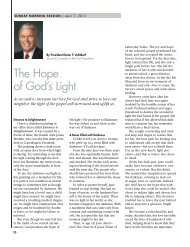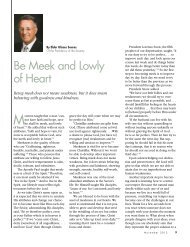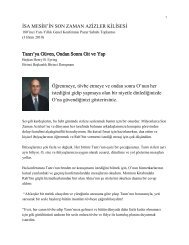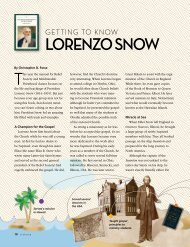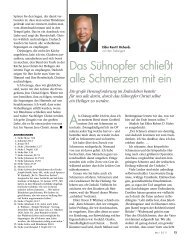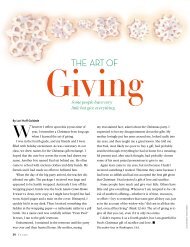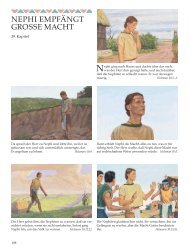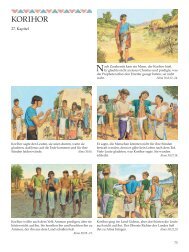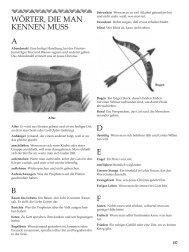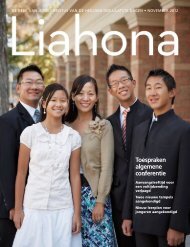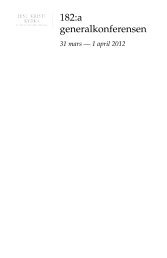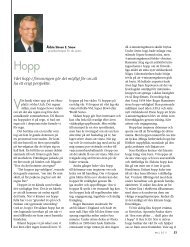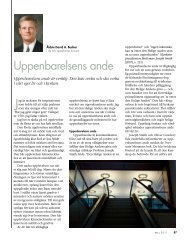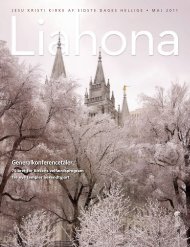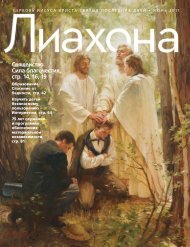Ensign, Nov. 2007 - The Church of Jesus Christ of Latter-day Saints
Ensign, Nov. 2007 - The Church of Jesus Christ of Latter-day Saints
Ensign, Nov. 2007 - The Church of Jesus Christ of Latter-day Saints
You also want an ePaper? Increase the reach of your titles
YUMPU automatically turns print PDFs into web optimized ePapers that Google loves.
46<br />
25. Isaiah 29:4.<br />
26. Isaiah foresaw that God would do “a marvellous<br />
work and a wonder” in the latter<br />
<strong>day</strong>s (Isaiah 29:14). Those words <strong>of</strong> Isaiah<br />
echoed in the ears <strong>of</strong> inhabitants <strong>of</strong><br />
ancient America: “<strong>The</strong> Lord will set his<br />
hand again the second time to restore his<br />
people from their lost and fallen state.<br />
Wherefore, he will proceed to do a marvelous<br />
work and a wonder among the<br />
children <strong>of</strong> men” (2 Nephi 25:17). That<br />
marvelous work would include the coming<br />
forth <strong>of</strong> the Book <strong>of</strong> Mormon and the<br />
Restoration <strong>of</strong> the gospel. Isaiah was<br />
quoted frequently in the Book <strong>of</strong> Mormon.<br />
A study <strong>of</strong> those quotations may be<br />
tedious, but it is not repetitious. Of 433<br />
verses <strong>of</strong> Isaiah in the Book <strong>of</strong> Mormon,<br />
234 differ from their biblical counterparts.<br />
27. Ezekiel 37:16–17.<br />
28. See 1 Nephi 11:13–20; Alma 7:10.<br />
29. See 3 Nephi 12–14.<br />
30. See Mosiah 3:7. A firsthand account <strong>of</strong><br />
His suffering was given to His latter-<strong>day</strong><br />
prophet (see D&C 19:16–19).<br />
31. <strong>The</strong> word resurrection appears in 40 verses<br />
<strong>of</strong> the King James Version <strong>of</strong> the Bible;<br />
it appears in 56 verses in the Book <strong>of</strong><br />
Mormon. See also Jeffrey R. Holland, <strong>Christ</strong><br />
and the New Covenant: <strong>The</strong> Messianic<br />
Message <strong>of</strong> the Book <strong>of</strong> Mormon (1997),<br />
238–41.<br />
32. Acts 19:2. See Acts 2:38 for the teaching <strong>of</strong><br />
Peter regarding the need for the gift <strong>of</strong> the<br />
Holy Ghost.<br />
33. History <strong>of</strong> the <strong>Church</strong>, 5:499.<br />
34. 1 Corinthians 15:41.<br />
35. D&C 76:96–98; see also 131:1.<br />
36. D&C 88:21–22.<br />
37. See Mosiah 16:10; Alma 42:23;<br />
Mormon 6:21.<br />
38. See Romans 5:11.<br />
39. Atonement: 28 times; atone or atoning:<br />
8 times; atoneth: 3 times. In several verses,<br />
the word atonement appears more than<br />
once (see 2 Nephi 9:7; Alma 34:9; 42:23).<br />
40. Revelation 14:6.<br />
41. See D&C 27:5; 128:20.<br />
42. <strong>The</strong> New Testament refers to “other sheep<br />
I have, which are not <strong>of</strong> this fold: them also<br />
I must bring, and they shall hear my voice;<br />
and there shall be one fold, and one shepherd”<br />
(John 10:16). That doctrine is clarified<br />
in the Book <strong>of</strong> Mormon. It bears<br />
record <strong>of</strong> the resurrected Lord speaking to<br />
people <strong>of</strong> ancient America. <strong>The</strong>re the Lord<br />
said, “Ye are they <strong>of</strong> whom I said: Other<br />
sheep I have which are not <strong>of</strong> this fold;<br />
them also I must bring, and they shall hear<br />
my voice; and there shall be one fold, and<br />
one shepherd” (3 Nephi 15:21).<br />
A limited account <strong>of</strong> Paul’s knowledge<br />
<strong>of</strong> baptism for the dead appears in the<br />
New Testament (see 1 Corinthians 15:29).<br />
Only in scriptures <strong>of</strong> the Restoration is<br />
that divine doctrine clarified (see D&C<br />
124:29–30, 41; 128:1, 11–12, 16–18;<br />
138:47–48).<br />
43. 3 Nephi 9:15–16, 18, 20–22.<br />
44. See 3 Nephi 9:14; D&C 30:8.<br />
PRIESTHOOD SESSION<br />
October 6, <strong>2007</strong><br />
Raising the Bar<br />
ELDER L. TOM PERRY<br />
Of the Quorum <strong>of</strong> the Twelve Apostles<br />
Be certain that you easily clear the minimum standards<br />
for service as a missionary and that you are continually<br />
raising the bar.<br />
Iwas privileged last month to be<br />
assigned to attend a seminar with<br />
the mission presidents from the<br />
North America West Area. Among the<br />
mission presidents in attendance was<br />
my son, Lee. He had been called to<br />
serve before I had completed my<br />
yearlong assignment in the Europe<br />
Central Area Presidency. It had been<br />
three years since I had spent any time<br />
with my son, other than a few short<br />
visits while passing through his area<br />
on other assignments.<br />
After a get-acquainted dinner with<br />
all <strong>of</strong> the mission presidents and their<br />
wives, Lee and I, with our wives, went<br />
to my hotel room for a visit. Our conversation,<br />
<strong>of</strong> course, centered on missionary<br />
work. Lee explained what had<br />
happened to his missionaries since<br />
President Hinckley asked us to raise<br />
the bar on qualifications for missionary<br />
service. He reported a decided<br />
improvement in the preparation <strong>of</strong><br />
the missionaries arriving in the mission<br />
field. <strong>The</strong> conversation led us to<br />
recall an experience Lee and I had<br />
while he was attending high school.<br />
Lee was a member <strong>of</strong> his high<br />
school track team—he both sprinted<br />
and high-jumped. During the 1968<br />
Summer Olympic Games held in<br />
Mexico City, the world became enamored<br />
with a little-known high jumper<br />
named Dick Fosbury. He had experimented<br />
with a new high-jumping<br />
technique that involved sprinting diagonally<br />
toward the bar, then curving<br />
and leaping backward over the bar. It<br />
came to be called the Fosbury flop.<br />
Like many others, Lee was intrigued<br />
by this new technique, but until the<br />
new school year started, he didn’t have<br />
a place to practice it. I came home one<br />
evening to find him practicing the<br />
Fosbury flop in our basement. He had<br />
set up two makeshift standards by<br />
stacking chairs, and he was jumping<br />
over a broomstick set on the chairs,<br />
using a s<strong>of</strong>a to cushion his landing. It<br />
was very clear to me that the s<strong>of</strong>a<br />
would not hold up under such treatment,<br />
so I called a halt to his indoor<br />
high-jumping. Instead, I invited him to<br />
go with me to a sporting-goods store,<br />
where we purchased some foam<br />
padding to use for landing and highjumping<br />
standards so he could move<br />
the activity out <strong>of</strong> doors.



